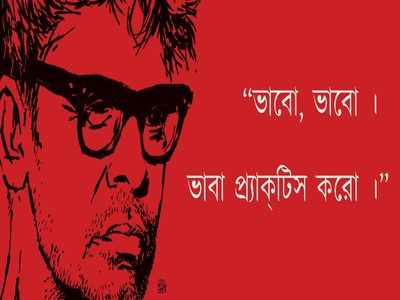- News
- entertainment
- bengali
- movies
- Ritwik Ghatak: Lesser-known facts about the celluloid rebel
Trending
This story is from November 4, 2019
Ritwik Ghatak: Lesser-known facts about the celluloid rebel
Ritwik Ghatak’s works are still a testament to the social, personal and political turmoil he faced in life.

Many filmmakers have redefined Indian cinema over the years, with some received international glory and few others endured abomination from political circles for narrating stories which reflected the injustice by society and governments. Nowhere was this clearer than in Bengali film history, in which Satyajit Ray was idolized in the first category, while the second saw its torchbearer in controversy’s favourite child Ritwik Ghatak.Often termed one of the pioneers of parallel cinema movement in India, Ghatak used to tell riveting stories on the Bengal partition, of which he was himself a victim. Ritwik Ghatak’s works are still a testament to the social, personal and political turmoil he faced in life. Scroll down to have a look at some of the almost forgotten, interesting facts about the celluloid rebel who utilized cinema as a political tool.

Hrishikesh Mukherjee’s 1957 hit Musafir grabbed National Award and was also awarded the Certificate of Merit for being the Third Best Feature Film in Hindi. But, did you know the screenplay of this cult classic was penned by Ritwik Ghatak along with Hrishikesh Mukherjee. Musafir was the directorial debut of Hrishikesh Mukherjee and had a stellar cast of Dilip Kumar, Kishore Kumar, Keshto Mukherjee, Suchitra Sen and Nirupa Roy. Music for this film was composed by the great Salil Choudhury. Ritwik Ghatak had already made directorial debut with Nagarik (1952) by then but had to postpone its release due to lack of funds. ‘Musafir’ gave him the chance to add enough resources to start his second directorial Ajantrik (1958).
Many believe the seed of partition oriented films was actually reaped at that time when Ghatak appeared in Nemai Ghosh’s critically acclaimed ‘Chinnamul’ (The Uprooted) in 1950. The film received a great appreciation from Russian filmmaker Vsevolod Pudovkin. He was so impressed with film that he later bought the film to release it in Russia. Incidentally, Ghatak was praised for acting in three of his own films later – ‘Subarnarekha’ (1962), ‘

The Sangeet Natak Akademi sponsored documentary saw Ustad Ali Akbar Khan as the music advisor. However, it raised few eyebrows during its release as Ritwik Ghatak’s name was absent on the credits section but was later included in the online database. In 1976, during an interview the ace filmmaker revealed how excited he was to be a part of this project and his work experience with Ustad Alauddin Khan. “He was my Guru, yet really crazy. On behalf of the Sangeet Natak Academy, I was apponted to make a documentary film on his life and I came to know so many things about him which I didn’t even know earlier. Alauddin Saheb himself shared the stories with me. He used to love me,” said Ritwik Ghatak in that interview.
During his tenure at the Pune Film Institute, Ritwik Ghatak made a 35 mm short film in Hindi named ‘Fear’. Interestingly Subhash Ghai, the legendary Bollywood director and celebrated actor Asrani acted in this short film. At that time, they were the students of the Pune Film Institute. Ghatak later revealed in an interview he can make a short film every day and this was like an exercise for every students of the acting department.
The National Film Archive of India took the initiative to restore three unfinished works of Ghatak and they succeeded in December 2016. The film reels have now been preserved for research work and educational purposes. However, the reasons that forced Ritwik Ghatak to stop shooting for ‘Kato Ajanare’ (1959), ‘Bagalar Banga Darshan’ (1963) and ‘Ronger Golam’ (1968) could only be traced in his individualist temperament and an invincible attitude that he never wanted to compromise.

This Bengali film is often regarded as India's first science fiction. ‘Ajantrik’, Ghatak's first commercial film as a director, revolves around a poor taxi driver (Kali Banerjee) who has a so-called 'living' car. The protagonist Bimal seemed to be an influence from the cynical taxi driver Narasingh (played by Soumitra Chatterjee) in Satyajit Ray’s ‘Abhijan’ (1962). The unique subject made it one of the earliest Indian films that focused on an inanimate object. It was adapted from a Bengali short story of the same name written by Subodh Ghosh. ‘Ajantrik’ also received a special entry for screening at the Venice Film Festival in 1959.
Ritwik Ghatak wrote five plays focusing particularly on the Bengal Famine and the tragic aftermath of the Partition. His theatrical works were translated into English and compiled into a single volume: ‘Charter’ (Dalil) - ‘Communication’ (Sanko), ‘Agony’ (Jwala), ‘Ablaze’ (Jwalanta) and ‘That Woman’ (Shei Meye). But the sad part is this book doesn’t give the actual dates of writing, or any details of performance, if there have been any. However, all these plays try to reprise the popular themes of his critically acclaimed hard-hitting films – the preoccupation with Partition and migration.
Co-writer of Hrishikesh Mukherjee’s ‘Musafir’ screenplay

Hrishikesh Mukherjee’s 1957 hit Musafir grabbed National Award and was also awarded the Certificate of Merit for being the Third Best Feature Film in Hindi. But, did you know the screenplay of this cult classic was penned by Ritwik Ghatak along with Hrishikesh Mukherjee. Musafir was the directorial debut of Hrishikesh Mukherjee and had a stellar cast of Dilip Kumar, Kishore Kumar, Keshto Mukherjee, Suchitra Sen and Nirupa Roy. Music for this film was composed by the great Salil Choudhury. Ritwik Ghatak had already made directorial debut with Nagarik (1952) by then but had to postpone its release due to lack of funds. ‘Musafir’ gave him the chance to add enough resources to start his second directorial Ajantrik (1958).
First appeared as an actor in ‘Chinnamul’
Many believe the seed of partition oriented films was actually reaped at that time when Ghatak appeared in Nemai Ghosh’s critically acclaimed ‘Chinnamul’ (The Uprooted) in 1950. The film received a great appreciation from Russian filmmaker Vsevolod Pudovkin. He was so impressed with film that he later bought the film to release it in Russia. Incidentally, Ghatak was praised for acting in three of his own films later – ‘Subarnarekha’ (1962), ‘
Titash Ekti Nadir Naam’ (1973) and ‘Jukti Takko aar Gappo’ (1974).
He Directed Ustad Alauddin Khan documentary (1963)

The Sangeet Natak Akademi sponsored documentary saw Ustad Ali Akbar Khan as the music advisor. However, it raised few eyebrows during its release as Ritwik Ghatak’s name was absent on the credits section but was later included in the online database. In 1976, during an interview the ace filmmaker revealed how excited he was to be a part of this project and his work experience with Ustad Alauddin Khan. “He was my Guru, yet really crazy. On behalf of the Sangeet Natak Academy, I was apponted to make a documentary film on his life and I came to know so many things about him which I didn’t even know earlier. Alauddin Saheb himself shared the stories with me. He used to love me,” said Ritwik Ghatak in that interview.
His short film ‘Fear’ (1965) had Subhash Ghai and Asrani
During his tenure at the Pune Film Institute, Ritwik Ghatak made a 35 mm short film in Hindi named ‘Fear’. Interestingly Subhash Ghai, the legendary Bollywood director and celebrated actor Asrani acted in this short film. At that time, they were the students of the Pune Film Institute. Ghatak later revealed in an interview he can make a short film every day and this was like an exercise for every students of the acting department.
Unfinished works of Ritwik Ghatak
The National Film Archive of India took the initiative to restore three unfinished works of Ghatak and they succeeded in December 2016. The film reels have now been preserved for research work and educational purposes. However, the reasons that forced Ritwik Ghatak to stop shooting for ‘Kato Ajanare’ (1959), ‘Bagalar Banga Darshan’ (1963) and ‘Ronger Golam’ (1968) could only be traced in his individualist temperament and an invincible attitude that he never wanted to compromise.
First commercial release ‘Ajantrik’

This Bengali film is often regarded as India's first science fiction. ‘Ajantrik’, Ghatak's first commercial film as a director, revolves around a poor taxi driver (Kali Banerjee) who has a so-called 'living' car. The protagonist Bimal seemed to be an influence from the cynical taxi driver Narasingh (played by Soumitra Chatterjee) in Satyajit Ray’s ‘Abhijan’ (1962). The unique subject made it one of the earliest Indian films that focused on an inanimate object. It was adapted from a Bengali short story of the same name written by Subodh Ghosh. ‘Ajantrik’ also received a special entry for screening at the Venice Film Festival in 1959.
He wrote five plays
Ritwik Ghatak wrote five plays focusing particularly on the Bengal Famine and the tragic aftermath of the Partition. His theatrical works were translated into English and compiled into a single volume: ‘Charter’ (Dalil) - ‘Communication’ (Sanko), ‘Agony’ (Jwala), ‘Ablaze’ (Jwalanta) and ‘That Woman’ (Shei Meye). But the sad part is this book doesn’t give the actual dates of writing, or any details of performance, if there have been any. However, all these plays try to reprise the popular themes of his critically acclaimed hard-hitting films – the preoccupation with Partition and migration.
End of Article
FOLLOW US ON SOCIAL MEDIA








